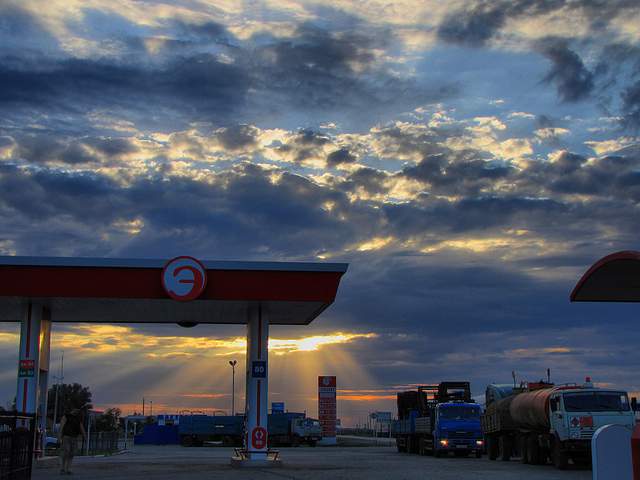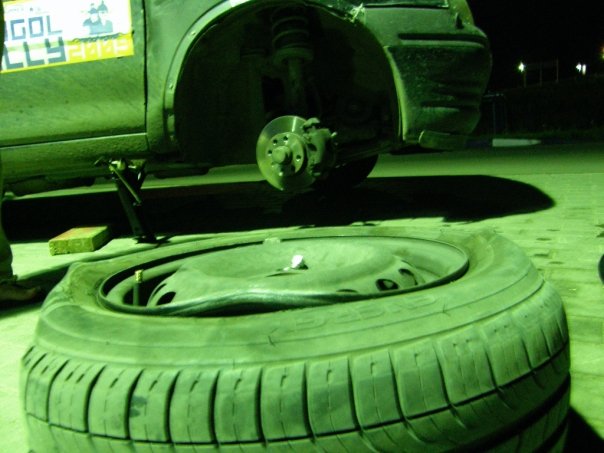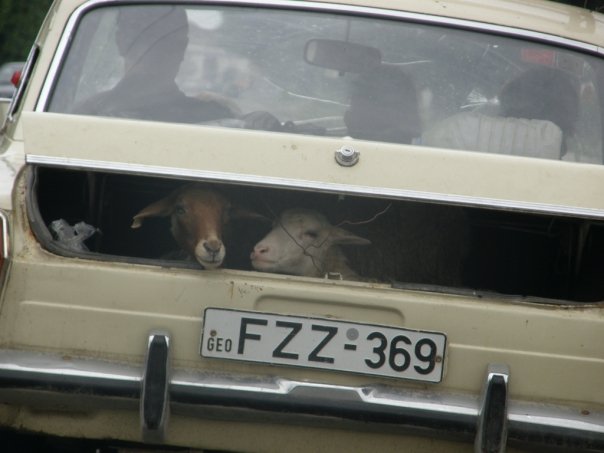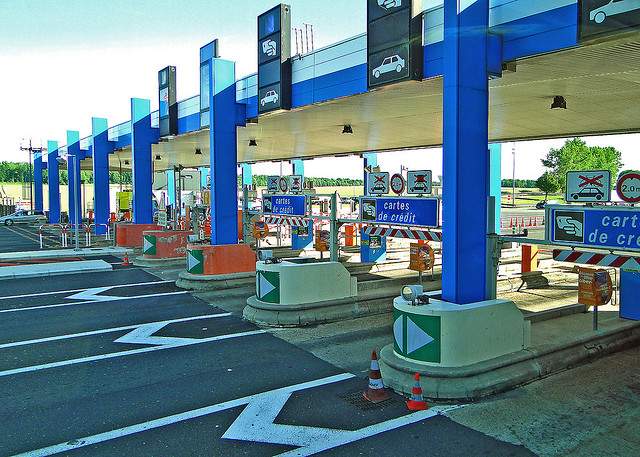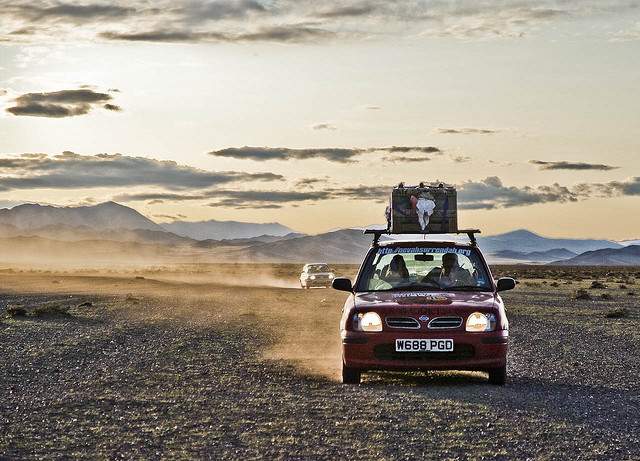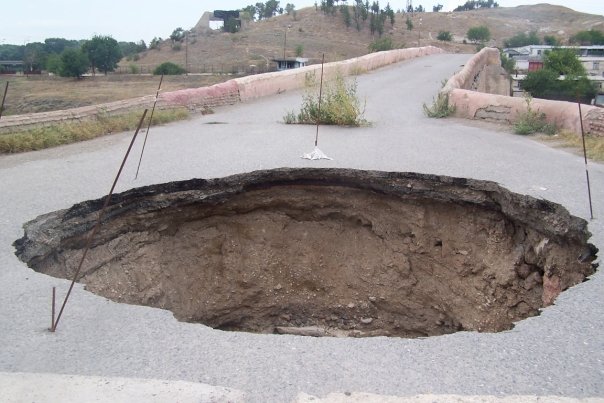Whether your journey is an extended car trip across the US or from Paris to Peking, a car is a precise machine that will give you more than you will give it, but you must give it something. You have your tire iron, your map, carne du passage, and international drivers license, but what are you missing? Many automotive problems occur because they might never occur to you to be problems, until you’re stranded on the side of the road and it becomes your only problem.
Over the summer of 2009, a few friends and I went on the Mongol Rally: a car race from Barcelona, Spain to Ulaan Baator, Mongolia. It took us months to prepare, and weeks to drive. We prepared for everything we could, but having never driven this far, let alone through unknown (to us) territory, we learned many lessons along the way. Listed below are eight tips for anyone contemplating an extreme global road trip.
Remember the fluids, filters, and fuses
This one is obvious, for obvious reasons. A car engine cannot operate without the sweet liquor of lubricating oil, coolant, brake fluid, steering fluid, and don’t forget, windshield wiper fluid. I would also carry at least enough for a refill of the car. In our case on the Mongol Rally, I wish we had enough for two refills, as we had a hole in the oil pan. When we thought we closed it and filled it back up with oil, all that oil fell out of the engine again.
Pack filters: oil filter, fuel filter, air filter. Change them yourself before you start out and carry an extra with you. If you are going to multiple countries they can be useful for bartering with a mechanic, or you have a spare so as not to suffer from being overcharged or lacking the part entirely.
Fuses are one of those things you don’t think about till they’re gone. Fuses allow all the electrical components of your car to work properly. On my trip, it took a long time to figure out that the windshield wipers didn’t work because of a busted fuse. Luckily, it didn’t rain until three-quarters of the way through the trip, but driving at night on narrow roads with out arm out the window cleaning the windshield is not something I recommend. Fuses run everything important in your car, like the fuel pump…which, ya know, is kinda vital.
In general, make sure you have a rudimentary automotive tool kit that includes proper size tools for your engine, and doing things like changing the spark plugs or head gasket. The wise man will also have a mechanic give the car a look to see if anything is glaringly wrong. There are whole books and careers devoted to the care and repair of automobiles; read up, starting with routine maintenance. Youtube has great videos as well.
We discussed road tripping in our weekly RTWChat on Twitter. Read the recap here and join us every Wednesday at 3:30 EST!
Check gas prices
Be prepared to budget for the variable gas prices. When planning mileage, we used an average gas price multiplied by the distance and gas mileage of the car. That was wrong. Driving through Turkey almost bankrupted the entire trip: I later found out they have the most expensive gas in the world. Russia, on the other hand was a civilized $.50 a gallon. For our six week trip, we probably spent nearly half of our gas money in the three days driving across Turkey.
Of course, Wikipedia has an article that is frequently updated with average gas prices from nearly every country around the world. Keep in mind that these prices may not reflect where you are going. They may be the price in an urban center, which might not be accurate if you are doing country driving.
[social]
Don’t make our mistake, and be prepared for a huge increase in gas prices.
Should you carry extra gas cans? It depends on how far from civilization you think you’ll be. I recommend bringing one for two reasons. One, if you think you’ll be out of reach of gas stations, it helps to increase your car’s range. Be careful, as it also increases your car’s weight and worsens the gas mileage. Two, some gas stations, in Russia for example, ask you to pay for the gas before you buy it. If you buy too much, you lose that money. Better to have a gas can to put the extra in. But never keep a gas can containing gas inside the car. The fumes will overpower you, and there is a risk of a leak or spill. If possible have a permanently mounted can on the outside of the car.
By far the best kind of gas can is the nicknamed “Jerry cans” of WWII fame (The German army cans were so much better than the Americans that the Americans would pick up the cans from ruined German vehicles if possible).
Bring a compass and know how to use it
Everyone might bring a map, and even perhaps a GPS, but maps are near useless at times without a compass, and it’s a fools errand to rely on a GPS in an area that is buttressed with wilderness.
A compass, the unsung hero of modern navigation, will get you out of tight spots, and is indispensible even if you have a map. When driving along the coast, it’s easy to tell which way is north, but when you are driving through Siberia, you could go 1000 miles in the wrong direction and not figure it out…ever.
On our trip, we had maps through Europe, but we completely switched the route that we planned for months. Instead of driving through Kazakhstan, we drove around through Russia instead with no map for the first half of the trip. However, our compass proved to be invaluable as we knew we had to keep going (and going) East.
Don’t underestimate the value of a hammer
When a tire goes flat, and you have your traditional jack and tire-iron, you will be SOL on the side of the road if your rim is bent. With a hammer, knock the rim, not only into shape, but enough to make it air-tight with the tire once again. My friend bought a rubber mallet as a joke for three Euros at a rest stop. That joke saved our skins at 2 am on the side of the road in Western Siberia.
Speaking of tires, also bring a 2×2 ft square of carpet or wood to put the jack on. If you are on soft ground, your jack will sink right in; you stand a better chance with a wide board underneath.
Also, make sure your spare is the proper size! Our spare tire that came with the car was one inch larger than it should have been. When our tire was flat, we had to drive on a tilt to the nearest tire shop. Steering is much more difficult as you need to keep turning just to go straight!
Know what you are required to have in your car
America is pretty lenient when it comes to automotive preparedness. As long as you follow the rules of driving, and keep your speeding modest, you will be okay. However, in many European countries, it is required that you have proper roadside gear. Not having things like reflective vests can land you a ticket. In Russia, people were pulled over and even their engine oil was checked.
Every country requires slightly different items in your car. We got pulled over because our headlights were not up to code, but the six countries we passed through already didn’t seem to have a problem. The British AA, Automotive Association, which is like the American AAA, American Automotive Association, has good information for what you need in your car by country. Check out their “Rules & Regulations Abroad” drop down. This will give you an idea of European standards. Probably the most noticeable item is a reflective vest.
Cars should always come with the proper tire iron and car jack, some safety reflectors to warn traffic, and a rudimentary first aid kit. I would definitely consider upgrading the first aid kit. Also a headlamp is more valuable than a flashlight for working on a car in low lighting.
Prepare for tolls
Many countries have tolls like you would see in the United States. In some countries; however, there are stickers you need to buy at a gas station and display on the windshield to indicate you have paid the toll. Do a little research to figure out what is needed. Also, figure out total amount of tolls you will need to pay. We did not account for the fact some toll roads would charge 70 Euros!
Again, Wikipedia comes to the rescue again with a list of major toll roads around the world. You can then link out to these toll road websites and find the exact cost of your travel.
Tolls can be a hassle for both time and money. We met other Mongol Ralliers who were doing a trip in six days when it was going to take us three. When we asked why, they responded “tolls.” Sure enough, by the first week was over, we had spent in excess of 300 Euros on tolls to save time on travel, as well as missed out on local back roads.
Insurance
Insurance can be a tricky situation and will vary from country to country. Your US based car insurance might offer options to extend your coverage for a modest additional fee if you are over 25. It can be very steep if you are under 25. If you are an EU citizen, it is much easier to get insurance in the EU, of course. Some third party insurance dealers will give you insurance for a modest fee.
Many countries will want proof of your insurance as you enter and force you to buy even more insurance at the border. It is typically in the area of $25, and it might be a reasonable idea so as not to open the citizenry to questionable drivers without some moniker of protection.
I don’t recommend any particular amount of insurance, but most countries will require the third-party insurance purchased at the border so be prepared for that cost.
As a side note, be able to prove you own the car or are renting it. Our car was towed in Spain while we were preparing for our trip. We went inside to have breakfast, and when we came out thirty minutes later, it was gone! When we went to get it back, it took the whole day as we couldn’t prove the car actually belonged to us as we didn’t have the proper documents that the dealer never gave to us!. We went back to the dealer, back to the DMV, back to the impound lot. That one day we thought all was lost.
Getting pulled over
Many European countries do not pull you over from behind like in the United States but signal you from the side of the road, or pull in front of you and slow down. Some police vans even have a blinking sign that says “follow me” in several languages on the back.
When we saw this van in Czech Republic, we didn’t think they were referring to us at first, and we thought how bizarre this system is. However, when my friend tried to switch lanes and pull in front of the van, we realized, through first shaking and frantic waving,what was happening. Russia has these ‘GDI’ stations on the way into and out of town. They are like small checkpoint/speed traps. They have someone holding a baton to pull you over if you speed through them. I was pulled over six times in three days before I figured that one out.
Be friendly and don’t panic. Some police officers in some countries want money, most do not. Even if you do speak the language, I might recommend that you pretend you don’t. A foreign national who doesn’t speak the language who doesn’t understand what you’re trying to ask of him isn’t worth a $30 dollar ticket.
But don’t do anything that would deserve more than that, and always smile.
Your homework
- Learn to read a compass and change a tire, oil filter, and fuel filter.
- Research gas prices along your route.
- Find out what toll roads you will need to use and how much they are. Learn how tolls are paid where you are going.
- Learn how police enforce traffic laws.
- Find out what each country requires in your car.
- Purchase your insurance and find out what is needed in each country.
Your packing list
- Compass
- Hammer
- “Jerry” Can
- Fuel filter
- Air filter
- Oil filter
- Fuses
- Oil (to fill the engine twice)
- Engine belt
- Coolant, and steering fluid
- Automotive tool kit
- First aid kit updated for your itinerary
- A surface for your car jack
- Headlamp (with batteries of course)
- International driver’s license, insurance, and proof of car ownership
Keep these ideas in your head, these tools in your trunk, and this information on hand and it might be the difference between an automotive disaster and global road-trip adventure.

